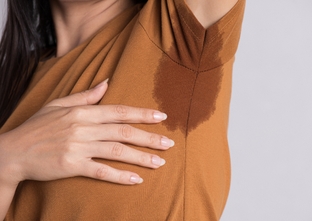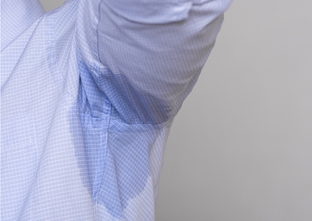Primary Axillary Hyperhidrosis
~10 million patients in the US have primary axillary hyperhidrosis and many still struggle to stay dry1-3
The condition leaves patients with more than just visible sweat stains—it causes distress that impacts their self-esteem2,4
- 69% reported experiencing constant worry about noticeable sweating4*
- >70% reported that excessive sweating has had negative impact on their social life2†
Excessive sweating can look different for different patients



Failing to stay dry leads patients to resort to several coping mechanisms that often fail to manage their excessive sweat and disrupt their day-to-day. This can include1,3-5:
- Frequently changing clothes or layering
- Avoiding certain fabrics and wearing dark loose clothing
- Bathing multiple times a day
- Placing napkins in underarms under clothing
time and effort concealing sweat.1,3
1 in 2 patients have never discussed their excessive sweating with a healthcare provider.1,2
Why? They are not aware it is a condition or they believe that nothing can be done to treat it.1,2


Indication
Sofdra™ (sofpironium) topical gel, 12.45% is an anticholinergic indicated for the treatment of primary axillary hyperhidrosis in adults and pediatric patients 9 years of age and older.
IMPORTANT SAFETY INFORMATION
Contraindications
Sofdra is contraindicated in patients with medical conditions that can be exacerbated by the anticholinergic effect of Sofdra (e.g., glaucoma, paralytic ileus, unstable cardiovascular status in acute hemorrhage, severe ulcerative colitis, toxic megacolon complicating ulcerative colitis, myasthenia gravis, Sjögren’s syndrome).
Warnings & Precautions
Urinary retention
Use Sofdra with caution in patients with a history or presence of documented urinary retention. Patients should discontinue use immediately and consult a healthcare provider should any signs or symptoms of urinary retention develop (e.g., difficulty passing urine, distended bladder).
Control of Body Temperature
In the presence of high ambient temperature, heat illness (hyperpyrexia and heat stroke due to decreased sweating) can occur with the use of anticholinergic drugs, including Sofdra. Patients should avoid using Sofdra if not sweating when in hot or very warm environmental temperatures.
Operating Machinery or an Automobile
Transient blurred vision may occur with Sofdra. If blurred vision occurs, discontinue use and avoid engaging in activities that require clear vision (e.g., operating a motor vehicle or machinery, performing hazardous work) until the symptoms have resolved.
Adverse Reactions
The most common adverse reactions (≥2%) are dry mouth, vision blurred, mydriasis, and urinary retention. The most common local skin reactions (≥2%) are pain, erythema, dermatitis, pruritus, irritation, and exfoliation.
Drug Interactions
Avoid coadministration of Sofdra with other anticholinergic medications (due to risk of increase in anticholinergic adverse effects) and drugs that are strong inhibitors of CYP2D6.
Please see full Prescribing Information.